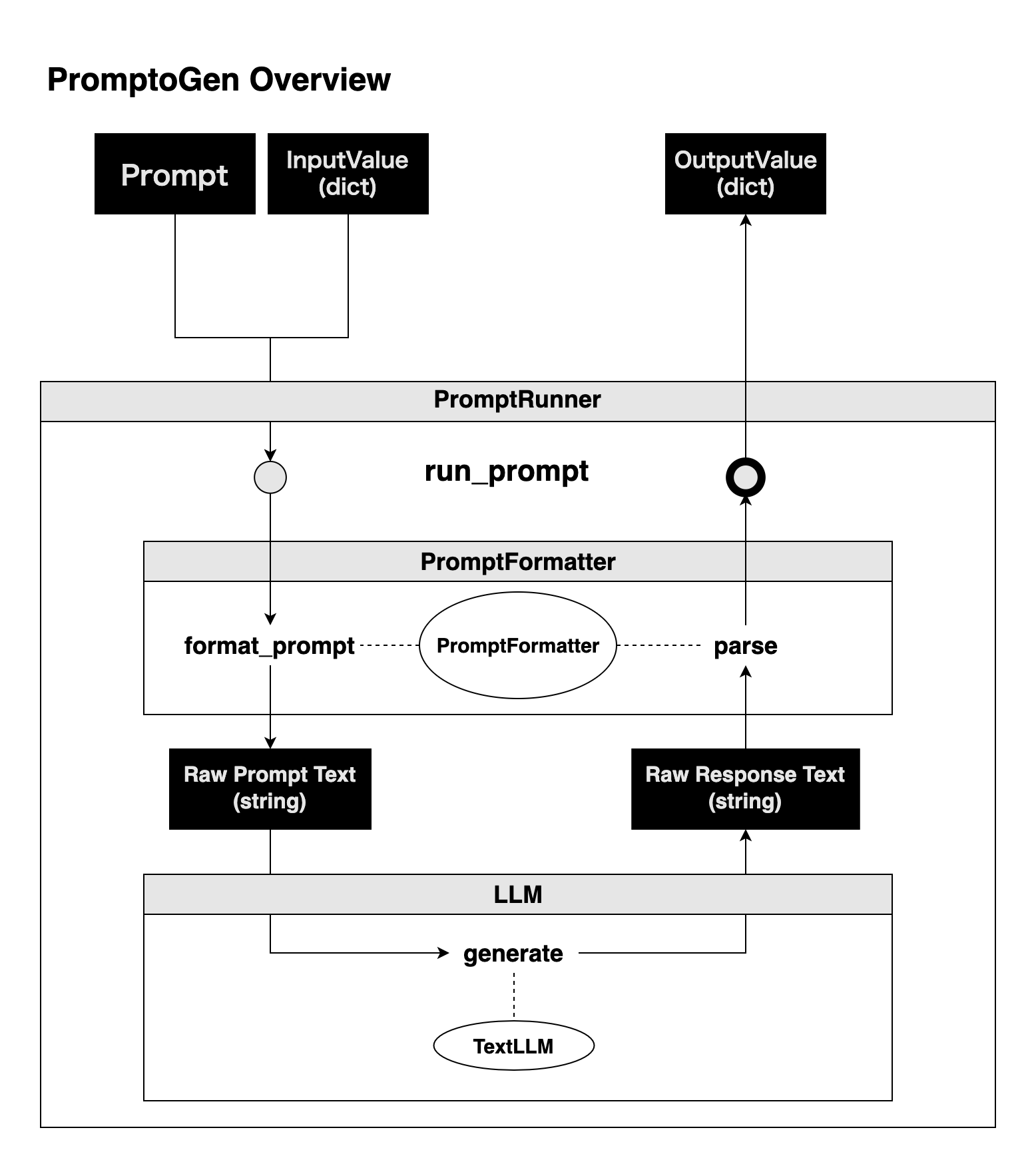PromptRunnerインターフェイス
PromptRunner: プロンプトの実行を簡略化¶
pg.PromptRunnerは、PromptoGenの中核的な部分であり、ユーザーが作成したプロンプトを効率よく実行する役割を果たします。最大の特徴は、具体的なLLMの実装を気にせずにプロンプトを実行できる 点にあります。これにより、プロンプトの作成や管理が大幅に簡略化されます。
使い方:¶
import promptogen as pg
# formatterはプロンプトのフォーマットを行うオブジェクト
formatter = pg.KeyValuePromptFormatter()
# TextLLMのインスタンス作成は`TextLLM`ページを参照
runner = pg.TextLLMPromptRunner(llm=text_llm, formatter=formatter)
# 実際のプロンプトの作成
summarizer = pg.Prompt(
name="Text Summarizer and Keyword Extractor",
# ...
)
# プロンプトの実行
input_value = {
"text": "In the realm of software engineering, ...",
}
output_value = runner.run_prompt(summarizer, input_value)
print(output_value)
なぜ pg.PromptRunner は便利か?¶
- 抽象化: ユーザーは具体的なLLMの実装を意識せずにプロンプトを実行できます。
- 一貫性: 同じプロンプトを異なるLLMで実行する際の変更を最小限に抑えられます。
- 拡張性: 新しいプロンプトの追加や既存プロンプトの修正が簡単です。
このように、pg.PromptRunnerは、PromptoGenでのプロンプトの実行を簡便かつ効率的に行うための強力なツールとなっています。
PromptoRunner の概要図¶
ユーザーは、利用したい TextLLM と PromptFormatter を選択し、 PromptRunner を作成します。
PromptRunner に対し、 Prompt と InputValue を渡すことで、 OutputValue を取得できます。
PromptRunnerへの入力:PromptとInputValuePromptRunnerからの出力:OutputValue
PromptRunner は、以下のような流れで動作します。
PromptとInputValueを受け取る- プロンプト文字列を生成する
- 生成したプロンプト文字列を
TextLLMに渡す TextLLMからの出力を受け取るPromptFormatterにより、出力をOutputValueに変換するOutputValueを返す

PromptRunner を実際に使用する¶
PromptRunner は run_prompt メソッドを持ちます。このメソッドは、プロンプトと入力を受け取り、出力を Value (つまり dict )にパースした結果を返します。
参考: PromptRunner抽象クラス
class PromptRunner(ABC):
@abstractmethod
def run_prompt(self, prompt: Prompt, input_value: Value) -> Value:
pass
実装例: pg.TextLLMPromptRunner¶
TextLLMPromptRunner によるプロンプトの実行は、以下の手順で行われます。
PromptFormatterを使用して、プロンプトと入力値をテキストにフォーマットします。TextLLMを使用して、テキストを生成します。PromptFormatterを使用して、生成されたテキストを解析して、Valueを返します。
pg.TextLLMPromptRunnerの実装を覗いてみる
class TextLLMPromptRunner(PromptRunner):
# ...
def __init__(self, llm: TextLLM, formatter: PromptFormatter):
self.text_llm = llm
self.formatter = formatter
def run_prompt(self, prompt: Prompt, input_value: Value) -> Value:
raw_req = self.formatter.format_prompt(prompt, input_value)
raw_resp = self.text_llm.generate(raw_req)
resp = self.formatter.parse(prompt, raw_resp)
return resp
使い方¶
ここでは、 TextLLMにはTextLLMで例を出した OpenAITextLLM クラスを使用します。
また、実行するプロンプトは Prompt で作成した summarizer プロンプトを使用します。
import promptogen as pg
class OpenAITextLLM(pg.TextLLM):
# 省略
text_llm = OpenAITextLLM("gpt-3.5-turbo")
formatter = pg.KeyValuePromptFormatter()
runner = pg.TextLLMPromptRunner(text_llm, formatter)
input_value = {
'text': "In the realm of software engineering, developers often collaborate on projects using version control systems like Git. They work together to create and maintain well-structured, efficient code, and tackle issues that arise from implementation complexities, evolving user requirements, and system optimization.",
}
resp = runner.run_prompt(summarizer, input_value)
print(resp)
# {'summary': 'Software developers collaborate using version control systems like Git to create and maintain efficient code and solve implementation and optimization issues.', 'keywords': ['software engineering', 'developers', 'collaborate', 'projects', 'version control systems', 'Git', 'code', 'implementation complexities', 'evolving user requirements', 'system optimization']}